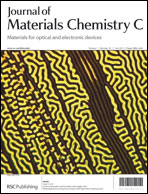A series of novel blue phosphorescent host materials, namely, CTP-1, CTP-2 and CTP-3 have been designed and synthesized through the Suzuki–Miyaura cross-coupling reaction between N-phenylcarbazole and biphenyl. Their thermal, photophysical and electrochemical properties were systematically investigated. These novel hosts show excellent thermal stability and high glass transition temperatures (Tg) ranging from 113 to 127 °C. The triplet energies of these three materials are significantly higher than that of (4,4′-bis(N-carbazolyl)-2,2′-biphenyl) (CBP, 2.56 eV) and that of the most popular blue phosphorescent material iridium(III) bis[(4,6-difluorophenyl)pyridinato-N,C2′] picolinate (FIrpic, 2.65 eV). These three novel materials have superior thermal and electronic properties for blue and white phosphorescent OLEDs. Blue emitting devices with an Ir-complex FIrpic as the phosphorescent dopant have been fabricated and show high efficiency with low roll-off. In particular, 40.4 cd A−1 at 100 cd m−2 and 38.2 cd A−1 at 1000 cd m−2 were achieved when CTP-1 was used as the host material. On the basis of this work, an all-phosphor white device with a current efficiency of 64.5 cd A−1 at 100 cd m−2 and 61.9 cd A−1 at 1000 cd m−2 has also been fabricated.

You have access to this article
 Please wait while we load your content...
Something went wrong. Try again?
Please wait while we load your content...
Something went wrong. Try again?


 Please wait while we load your content...
Please wait while we load your content...